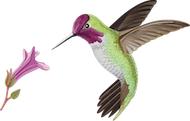As the Gottlieb Native Garden’s naturalist, Scott Logan documents the ever-changing array of wildlife species as they vary with the garden’s blooms, seasons and migratory patterns. While bringing these observations to life for all to experience, he also coordinates scientific research projects, and monitors the overall health and biodiversity of the garden. The Naturalist’s Journal also highlights the work the Gottliebs and Scott are doing to educate and inspire people to start gardening for wildlife with native plants.
Skunk Encounters
Striped Skunks have such a bad reputation for spraying whomever they encounter. That is the last thing they want to do. Skunks do not have an unlimited supply of the smelly stuff and must “recharge” once it sprays. If it completely depletes his scent glands […]
Migrating Western Tanagers
The Western Tanager, another one of our beautiful Neotropical birds, is usually seen in our area during spring migration. This tanager ranges farther north than any other tanager and can be found all the way into Canada, breeding in open coniferous and mixed woodlands forests. […]
Striped Racer
The most common snake in the GNG is the California Striped Racer – Coluber lateralis lateralis. Being diurnal, it is often seen foraging during the day with its head and forward part of its body held up off the ground as it searches for its […]
Western Kingbird
Two kingbird species are common to the Los Angeles area, Cassin’s and Western. Cassin’s Kingbirds can be found year-round, while Western Kingbirds are migratory and arrive here in Spring from the neotropics to breed. We have yet to have either of these species stay any […]
Two New Water Features
The GNG has two new water features in the back hillside garden, Installed a few months ago, they were pretty much ignored by wildlife. This was to be expected as wildlife needs to acclimate to changes in their surroundings. All it took was a little time. […]
Some are dainty eaters…
…others are not! California Scrub-Jays, like so many of our native birds, love live mealworms – and they are not shy about stuffing their beaks on each and every visit. The Oak Titmouse pictured in the banner above has quite the refined manners in comparison.
Thermal Imaging
Finding nocturnal wildlife is always a challenge. One of our more high-tech devices used in the garden at night is a Thermal Imaging Scope. This device picks-up infrared light waves that are emitting from every object in our environment. These energy waves are scanned by […]
Cooper’s Hawk Takes Flight
This adult Cooper’s Hawk quickly scans the garden as light rain falls, most likely looking for a meal. Cooper’s Hawks are bird hunting raptors that try to surprise their prey with speed, but more often than not their position is given away by other animal […]
Molting Fence Lizard
Could this be a case of a lizard’s bad hair day? Fence lizards began emerging from their hiding places recently and now many are molting. This egg-laden female basked in the sun as she twisted and turned to speed along the process of shedding her […]
Hummingbird and Fuchsia-Flowering Gooseberry
Our winter rains finally arrived, and with them flowers on spring blooming plants. Here an Allen’s Hummingbirds takes advantage of the nectar provided by the blooms of Ribes speciosum.

